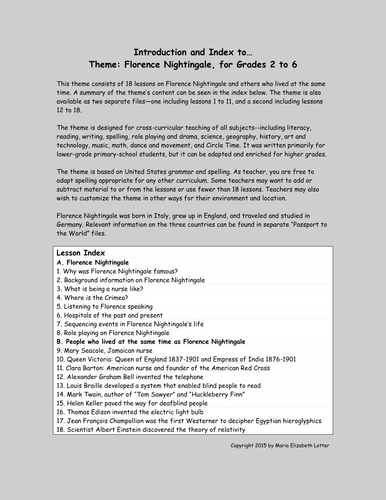


This richly illustrated theme consists of 18 detailed lessons and 22 worksheets on Florence Nightingale and others who lived at the same time. Contents for the theme and worksheets appear below. This resource is also available in two separate parts—lessons 1 to 11 and 7 additional lessons.
The theme is designed for cross-curricular teaching of all subjects--including literacy, reading, writing, spelling, role playing and drama, science, geography, history, art and technology, music, math, dance and movement, and Circle Time. It was written primarily for lower-grade primary students but can be adapted and enriched for higher grades.
The lessons are based on US grammar and spelling. Please feel free to adapt spelling, add or subtract material, use fewer than 18 lessons, and customize the theme in other ways.
Florence Nightingale was born in Italy, grew up in England, and traveled and studied in Germany. Info on the three countries are in separate “Passport to the World” files.
Theme
1. Why was Florence Nightingale famous?
2. Background information on Florence Nightingale
3. What is being a nurse like?
4. Where is the Crimea?
5. Listening to Florence speaking
6. Hospitals of the past and present
7. Sequencing events in Florence Nightingale’s life
8. Role playing on Florence Nightingale
9. Mary Seacole, Jamaican nurse
10. Queen Victoria: Queen of England 1837-1901 and Empress of India 1876-1901
11. Clara Barton: American nurse and founder of the American Red Cross
12. Alexander Graham Bell invented the telephone
13. Louis Braille developed a system that enabled blind people to read
14. Mark Twain, author of “Tom Sawyer” and “Huckleberry Finn”
15. Helen Keller paved the way for deafblind people
16. Thomas Edison invented the electric light bulb
17. Jean François Champollion was the first Westerner to decipher Egyptian hieroglyphics
18. Scientist Albert Einstein discovered the theory of relativity
Worksheets
Page 1. Title page and ToC
Page 2. Lesson 1 (advanced)
Page 3. Lesson 1 (less advanced)
Page 4. Word and Spelling Card
Page 5. Vocabulary List
Page 6. First Lesson 2 (advanced)
Page 7. First Lesson 2 (less advanced)
Page 8. Second Lesson 2 (advanced)
Page 9. Second Lesson 2 (less advanced)
Page 10. Third Lesson 2 (advanced)
Page 11. Third Lesson 2 (less advanced)
Page 12. Student Account
Page 14. Role Playing, Lesson 8
Page 15. Seacole, Lesson 9
Page 16. Lesson 10 -- Victoria (advanced)
Page 17. Victoria, Lesson 10 (less advanced)
Page 18. Barton, Lesson 11
Page 19. Bell, Lesson 12 (advanced)
Page 20. Bell, Lesson 12 (less advanced)
Page 21. Braille, Lesson 13 (advanced)
Page 22. Braille, Lesson 13 (less advanced)
Page 23. Lessons 14 to 18 Worksheet
The theme is designed for cross-curricular teaching of all subjects--including literacy, reading, writing, spelling, role playing and drama, science, geography, history, art and technology, music, math, dance and movement, and Circle Time. It was written primarily for lower-grade primary students but can be adapted and enriched for higher grades.
The lessons are based on US grammar and spelling. Please feel free to adapt spelling, add or subtract material, use fewer than 18 lessons, and customize the theme in other ways.
Florence Nightingale was born in Italy, grew up in England, and traveled and studied in Germany. Info on the three countries are in separate “Passport to the World” files.
Theme
1. Why was Florence Nightingale famous?
2. Background information on Florence Nightingale
3. What is being a nurse like?
4. Where is the Crimea?
5. Listening to Florence speaking
6. Hospitals of the past and present
7. Sequencing events in Florence Nightingale’s life
8. Role playing on Florence Nightingale
9. Mary Seacole, Jamaican nurse
10. Queen Victoria: Queen of England 1837-1901 and Empress of India 1876-1901
11. Clara Barton: American nurse and founder of the American Red Cross
12. Alexander Graham Bell invented the telephone
13. Louis Braille developed a system that enabled blind people to read
14. Mark Twain, author of “Tom Sawyer” and “Huckleberry Finn”
15. Helen Keller paved the way for deafblind people
16. Thomas Edison invented the electric light bulb
17. Jean François Champollion was the first Westerner to decipher Egyptian hieroglyphics
18. Scientist Albert Einstein discovered the theory of relativity
Worksheets
Page 1. Title page and ToC
Page 2. Lesson 1 (advanced)
Page 3. Lesson 1 (less advanced)
Page 4. Word and Spelling Card
Page 5. Vocabulary List
Page 6. First Lesson 2 (advanced)
Page 7. First Lesson 2 (less advanced)
Page 8. Second Lesson 2 (advanced)
Page 9. Second Lesson 2 (less advanced)
Page 10. Third Lesson 2 (advanced)
Page 11. Third Lesson 2 (less advanced)
Page 12. Student Account
Page 14. Role Playing, Lesson 8
Page 15. Seacole, Lesson 9
Page 16. Lesson 10 -- Victoria (advanced)
Page 17. Victoria, Lesson 10 (less advanced)
Page 18. Barton, Lesson 11
Page 19. Bell, Lesson 12 (advanced)
Page 20. Bell, Lesson 12 (less advanced)
Page 21. Braille, Lesson 13 (advanced)
Page 22. Braille, Lesson 13 (less advanced)
Page 23. Lessons 14 to 18 Worksheet
Something went wrong, please try again later.
Thank you for sharing your resource. This resource has been recommended for teachers by the TES Resource Team.
Report this resourceto let us know if it violates our terms and conditions.
Our customer service team will review your report and will be in touch.
$5.00
